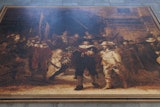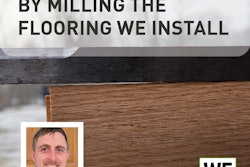The Problem
A colleague and I were called to inspect wood flooring in four homes in a new upscale subdivision in Virginia. The factory-finished solid strip oak flooring was making squeaking, popping and crackling noises.
The Procedure
The homes all had crawlspaces; the flooring had been stapled to a 34-inch OSB subfloor over wood joists that were 16 inches o.c. in most areas and 19.2 o.c. in others. Some of the wood flooring squeaked right away after occupancy, while other areas started making noises three to four months after occupancy. Later, it was noticed there was an issue with the springiness of the subfloor involving the spans and joist spacing, so the builder had done some retrofit work to stiffen the subfloor system. In addition, some areas of the wood floor had been replaced and others were face-nailed to address the noises, but these actions did not fix the problems.
The Cause
Upon walking into the homes, it was apparent there were humps in the flooring every 4 feet, which were from edge swell of the OSB panels. There were noises throughout the flooring; some boards would make the noise as many times as they were stepped on, while others would stop making the noise. The flooring itself was basically flat and together. Measurements of 20 runs of boards were within 116 inch plus or minus, so the flooring had been installed on size and remained that way. The flooring was at 8.5 to 9 percent moisture content (MC), while the subfloor averaged 13 to 14 percent. One house had a subfloor MC of 15 percent, and in two homes there was evidence of mildew on the subfloor when looking from underneath.
We took up sections of the flooring and the subfloor about 48 inches long and 24 to 30 inches wide. The fasteners were seated correctly, the fastener schedule was correct, and the tongue and groove configuration was correct. We did pull tests with testing machines to determine the fastener holding power in the OSB, and it did not perform as well as the industry testing that had been done previously regarding OSB and wood flooring fasteners.
Cases such as this demonstrate that in most cases, there is no black and white, only gray. The OSB wasn't holding the wood flooring fasteners, even though OSB is an approved subfloor for wood flooring and some of the OSB used involved higher-end, brand-name products from three manufacturers. There was evidence of previous moisture in the homes that contributed to the subfloor issues (the moisture caused thickness swell and movement, affecting the way fasteners were held in the flooring). There was no evidence that there were moisture problems at the time of the flooring installation, however.
How to Fix the Floor
As always, one option was to live with the issues, but that was not acceptable in this case. Other options were to replace the flooring by installing a minimum 58-inch plywood over the OSB before a new floor or to install a new floor by nailing and gluing. Most contractors opt for gluing and nailing, as it's the more cost-effective method.
In the Future
We found no evidence that the installer in this case did anything wrong. However, it's always best to address any concerns about the job site with the builder and owners in a written note before the flooring is installed, whether it's an indication of moisture problems or movement in the entire subfloor system. That way, when things don't perform as expected, it's easier to re-identify the problems associated with previously mentioned site inadequacies.































